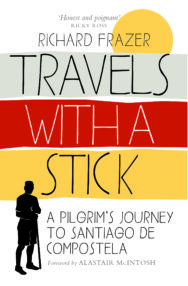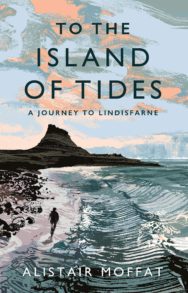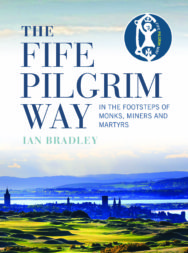‘We set out only to come back again, and every departure involves a return until we make the pilgrimage that awaits each and every one of us as we depart from this world.’
There have been a spate of great books on walking pilgrimages this year. David Robinson takes a look some of them and finds a variety of interesting journeys.
To the Island of Tides: A Journey to Lindisfarne
By Alistair Moffat
Published by Canongate
The Shepherd and the Morning Star
By Willie Orr
Published by Birlinn
The Spanish have a saying about pilgrimages that makes sense whether you say it backwards or forwards. La ruta nos apartó otro paso natural – ‘the path provides the natural next step.’ Of course it does, and that palindrome expresses a truth we have known for ages. Long before Chaucer’s Canterbury-bound pilgrims met at the Tabard Inn at Southwark or the first pilgrims sewed a scallop shell into their cloaks to show that they were walking to the shrine of St James at Santiago de Compostela, we have known all about how taking our fears and failings on a purposeful journey seems to make them disappear or allow us to face up to them. Ambulato solvitur, as Saint Augustine is supposed to have said. It will be made better by walking.
The best essay I have read on pilgrimages – and where I first came across that Spanish saying – is an article Robert Macfarlane wrote for the Guardian in 2012. In it, he tried to work out why so many people, agnostics as well as believers, want to wander in the spiritual footsteps of others. At the cathedral of Santiago de Compostela, the endpoint of the Camino pilgrimage routes, the number of visiting pilgrims makes the case perfectly: 690 in 1985; 327,378 in 2018. And this isn’t just something happening in Catholic southern Europe. It is happening in largely secular Scotland too. Why?
In Travels with a Stick (Birlinn, April 2019), Richard Frazer not only gives an engaging account of his own pilgrim’s progress along the Camino but shows how transformative the whole experience can be. In banning pilgrimages, he argues, the Kirk took a wrong turn 450 years ago: ‘If the Reformers wanted people to use their consciences, think for themselves, and come up with their own, very personal relationship with the universal mysteries … there is no better place to attempt this than on a pilgrimage, where all enjoy equal status.’ As minister of Greyfriars Kirk in Edinburgh, Frazer successfully pushed the Kirk to change its collective mind about pilgrimages, to the extent that more pilgrim walks are opening up in Scotland right now than in any other part of the UK.
Last month, this website featured a book about just one of them – Ian Bradley’s The Fife Pilgrim Way (Birlinn, June 2019), a hugely informative guide to the history of the places walkers will pass on the 64-mile path between Culross or North Queensferry and St Andrews which officially opens this month. On its signposts, they will see a small vertical ovoid logo based on a 15th century pilgrim’s badge discovered during excavations in St Andrews in 1998. It shows St Andrew being crucified on his diagonal cross, but because the right-hand edge of the badge was missing, it has been completed with the words ‘Fife Pilgrim Way’. As Bradley writes, this design ‘points to the brokenness of pilgrims, many of whom set out on their travels to seek forgiveness of sins and to come to terms with their failings.’ It also hints at ‘the incompleteness of every earthly journey. We set out only to come back again, and every departure involves a return until we make the pilgrimage that awaits each and every one of us as we depart from this world.’
That’s the context in which I’d like to mention two new books by Scottish writers who I don’t think know each other, but who are as affable, creative and thoughtful as any definition of contrariness allows. Yet even though both are defiantly agnostic, two places of pilgrimage – Iona and Lindisfarne – have played an important part in their lives.
Iona was where Willie Orr’s life turned around. When he arrived there, he writes in The Shepherd and the Morning Star (Birlinn, June 2019), he was an impoverished young actor who had just had a breakdown and was addicted to psychiatric drugs. He was also the eldest son of a politician who would go on to lead the Ulster Unionists and become Imperial Grand Master of the Orange Order (until a bigamy scandal cleared the way for Enoch Powell to take his parliamentary seat in 1974). Such establishment links were anathema to Willie, who became a shepherd, forestry worker, tenant farmer, mature student, historical researcher for Tom Devine, teacher and counsellor for disaffected and difficult teens.
I know Willie a small bit but enough to like him a lot, and in the 1990s commissioned him to write a column for the Weekend Scotsman under the byline ‘Rural Voltaire’ that distilled some of the wisdom acquired over his varied career. I didn’t, however, know many of the engrossing stories his book reveals such as how Iona Community founder George MacLeod sat up with him for two nights running to wean him off the drugs, or how RD Laing convinced him that his breakdown was entirely natural, nor did I realise some of the traumas revealed in his memoir brought about by his background and life experiences. But I did at least know that Iona was where he met his wife Jan, and I had some hint of how, even to an agnostic like him, that small Hebridean island was a ‘thin place where past, present and future meet, and the eternal is just below the surface’ and that the island, and the Iona Community in Glasgow, played a pivotal role in him getting his life back on track.
What constitutes ‘thinness’ is, I think, closely linked to pilgrimage itself. Iona and Lindisfarne are, of course, where saints – Columba and Cuthbert respectively – have trod, and walking in the footsteps of St Cuthbert is what Alistair Moffat sets out to do in To the Island of Tides (Canongate, 1 August 2019). The notion that places can somehow absorb the goodness of people who have lived there may well be superstition, but it’s one that we seem prepared to accept, which is why we are so ready to associate ourselves with the holy dead. As he tracks Cuthbert from Old Melrose to Lindisfarne, Moffat comes across plenty of examples: it’s why Walter Scott and Earl Haig wanted to be buried in the north transept of Dryburgh Abbey, and why people were prepared to vandalise St Cuthbert’s Cave in Northumberland by inscribing their names on the boulder by its entrance. On Lindisfarne, it’s why people attach plastic flowers and laminated cards in memory of loved ones to the benches on the Heugh. It’s as if people think that Shakespeare got things the wrong way round in Julius Caesar and that the evil that men do is buried with them while the good lives after them, somehow accessible in the ‘thin places’ of pilgrimage.
I don’t think Moffat really believes that. Though he’s writing a book about a Christian saint, he’s not a Christian himself, but someone who has always believed in the power of place to illuminate history. He’s right about that: surely you have to get up for the early morning communion service, to feel the cold, to hear the prayers that have been said to the same God for 13 centuries, to look out by night and see the dark hump of Bamburgh castle across the sea, to learn about the plants that provided the still hardly faded colours of the Lindisfarne Gospels – surely you have to find out all of these things to open up your mind to a long-dead saint from a small sandy island at the edge of Christendom. If he spent a week there, he writes, ‘perhaps some of the eternal spirits of that magical place would speak to me.’ Even though the Cuthbertian history is fascinating and written with Moffat’s customary elan, there’s clearly something more going on here.
And this bring us right back to where we started. To solving problems by walking, to facing up to fears by making up a journey, to making a pilgrimage – even an entirely secular pilgrimage – and realising the incompleteness of every earthly journey. Because as well as writing about Cuthbert from a firmly Borders perspective (fair enough: the English have claimed him as entirely their own for too long), To The Island of Tides is Moffat’s most personal book since his 2003 memoir Homing. Here, he is also looking back on his own life, his own family (the still-birth of a grand-daughter affected him badly), the mistakes he has made, and the slights and deceits of others he still hasn’t learnt to forgive and forget, but realises that he needs to. At 69, he has, he reckons, ‘ten more summers of active, healthy life in front of me, if I am lucky.’ So the journey to Lindisfarne (‘old name Ynys Medcaut, from Insula Medicata, meaning Isle of Healing’) has another purpose: to refresh his joy in life and help him learn how to face up to death. Pilgrimages have always done this, and maybe in a secular age we actually need them more than ever. La ruta nos apartó otro paso natural, after all.
To the Island of Tides: A Journey to Lindisfarne by Alistair Moffat is published by Canongate, priced £20.00
The Shepherd and the Morning Star by Willie Orr is published by Birlinn, priced £9.99.
ALSO IN THIS ISSUE

 Ducks, Newburyport
Ducks, Newburyport
‘The fact that what is it with this constant monologue in my head, the fact that why am I telling my …

 Alice Piotrowska Reviews: The Wind That Lays Waste
Alice Piotrowska Reviews: The Wind That Lays Waste
‘The tensions between them grow just as the thunderstorm brews on the horizon, and we’re all waiting …
















